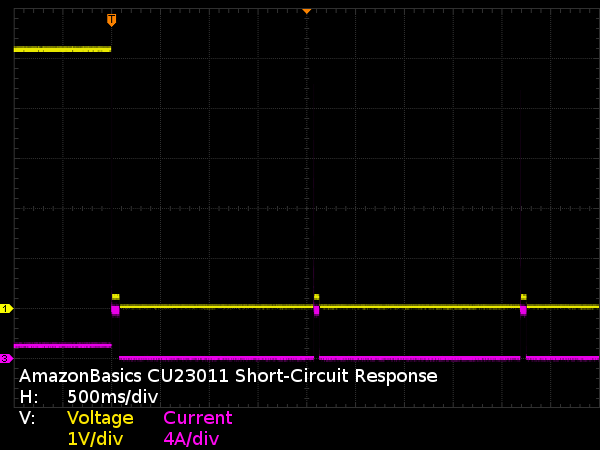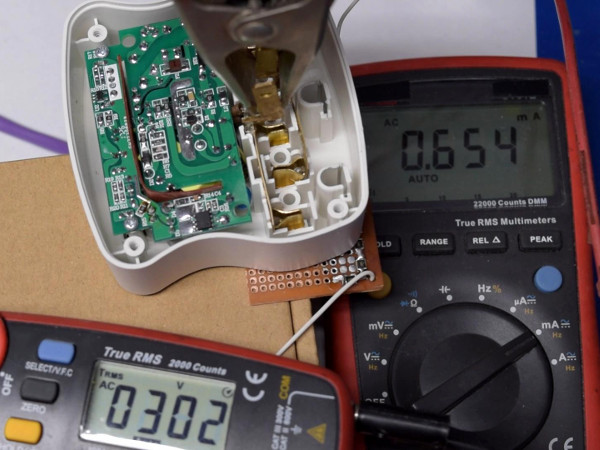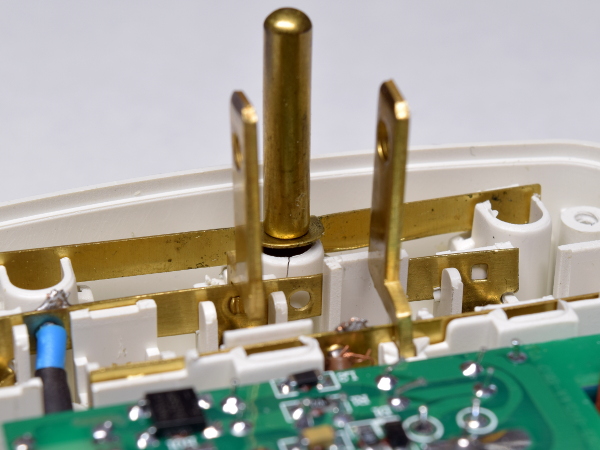AmazonBasics CU23011W Tap-Adapter: Top Performance, Imperfect Design
Transient Response
As usual with adapters featuring primary-side sensing instead of opto-coupler feedback, we get a 150mV dip that the adapter needs about 15ms to compensate for when the extra load is switched in, and a 150mV spike that takes about 20ms to settle after the additional load is removed. Transients of 100-150mV with 5-10ms settling time are par for the course, making the CU23011W worse than average for being 5-10ms slower.
This is still acceptable, just not praiseworthy.
Short Circuit Response
What happens under a short circuit condition? Current output is limited to a reasonable 4A for about 110ms before the controller turns the output off, then attempts to restart approximately every two seconds after that.
With an effective average current of only 200mA, attached connectors and cables should have no problem surviving an indefinitely long short circuit.
Isolation Withstand Test
Was my optimism about the board’s design and safety misplaced? Not at all. Amazon’s CU23011W had no trouble holding 3500V. In fact, after recording this video and realizing that leakage current was lower than expected, I decided to go back and re-measure. While doing so, I was watching leakage current instead of test voltage. The next time I looked at voltage, I had passed 3700V (200V more than intended), and leakage still didn’t go much beyond 700µA.
Why is the leakage current lower than expected? The adapter has inductors in the path from L-N terminals to output, and these cancel out part of the capacitor’s reactance.
So Close, Yet So Far
This was a mix of wonderment and disappointment. On one hand, we saw one of the best examples of isolation between primary and secondary sides, some of the best noise performance, decent efficiency, impressive voltage regulation, and better-than-rated output current. Apart from its somewhat sluggish transient response, the CU23011W qualifies as a top contender for best adapter in my tear-downs so far.
Get Tom's Hardware's best news and in-depth reviews, straight to your inbox.
Where Amazon's adapter loses points is in the rather weak connections between its prongs and outlet connection strips where the ground prong’s solder joints may be prone to breaking off. Meanwhile, the live and neutral prongs are susceptible to poor electrical contact with their respective strips.
The CU23011W reflects a great job on the electronics, undermined by shoddy electrical hardware work. It's an unfortunate combination.
-
Daniel Sauvageau Readers wanted a break from generic no-name adapters. Here's something a little different.Reply -
Daniel Sauvageau Reply
They always are. Only one transformer, so no independent regulation. Only one transformer secondary and only one synchronous rectifier, so no isolation between outputs. No electronic fuses or PPTCs either, not really a problem when output current is only 4A with limited duty cycle.20964213 said:you never let us know if the two outputs where indeed connected in parallel.
I doubt we'll be seeing independently regulated 5V outputs in any adapter. At most, we might get a DC-DC converter in QC/USB-PD adapters with some fixed 5V ports. -
ElectrO_90 Americans and the use of Metric... doesn't compute! I need my 7/87ths of a inch measurement ;)Reply -
Daniel Sauvageau Reply
I'm Canadian :)20965184 said:Americans and the use of Metric... doesn't compute! I need my 7/87ths of a inch measurement ;) -
Onus I really enjoy these teardowns. Between you & Aris, it keeps my inner geek well-fed. When I buy a multi-socket adapter of most any kind, often it is to put somewhere, plug in devices that wouldn't fit otherwise, and just leave it, so I'm less concerned about the physical wear issues than a frequent-plugger might be.Reply -
zodiacfml It's not bad till that wiggly part. It will just not pass much current. This will burn soon when used in the kitchen.Reply
I have an extension cord with USB charging ports and six AC outlets, it just costs a bit more but certainly safer, convenient, and can pass more current. -
froozeball Wonderful dissection as always Sir!Reply
It's like watching Auguste Dupin or Sherlock Holmes unravel the threads in a mystery, forming an inescapable conclusion.
Thanks for putting this type of product on my radar M. Sauvageau!




